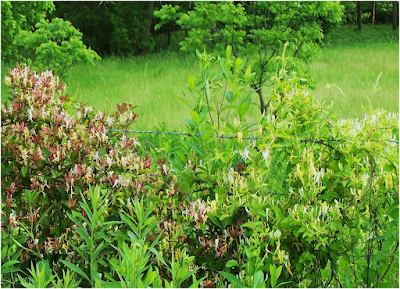The old name Woodbine
describes the twisting, binding nature of the honeysuckle through the
hedgerows of the Old World.
It was believed that
if honeysuckle grew around the entrance to the home it prevented a witch from
entering. In other places it's believed that grown around the doors it will
bring good luck. If it grows well in your garden, then you will be protected
from evil. In Ireland honeysuckle was believed to have a power against bad
spirits, and it was used in a drink to cure the effects of the evil eye.
Bringing the flowers
into the house will bring money with them.
Honeysuckle has long
been a symbol of fidelity and affection. Those who wear honeysuckle flowers are
said to be able to dream of their true love. Its clinging nature, in the book The Language of Flowers, symbolizes 'we are united in love,' and emphasizes the
bond of devotion and affection between two people. It was also believed that if
the blooms were brought into the house then a wedding would follow within a
year.
In the Victorian era
there was a ban on young girls bringing honeysuckle into the home because the
heady fragrance of the flowers was believed to cause dreams that were far too
risqué for their sensibilities.
The wood has been used to make walking sticks because of its nature to grow around and entwine saplings. Actually, I have never seen honeysuckle big enough for this, unless this is referring to the shrub?
The dried flowers are used for adding to pot-pourri, herb pillows and
floral waters. Also, scented cosmetics are made from the fresh flowers.

I was walking up in Yorkshire many years ago with a friend who is a botanist. We came across a group of highly twisted hazel trees. He said that honeysuckle had been removed long ago from the young trees with the intention of making hazel walking sticks but for some reason that hadn't happened and the oddly twisted trees grew to full size.
ReplyDeleteYour mention of the name Woodbine reminded me of the fine old song "Spencer the Rover" in which a man who had left his family finds himself far from home:
"The night fast approaching to the woods he resorted,
With woodbine and ivy his bed for to make.
There he dreamt about sighing, lamenting and crying,
Go home to your family and rambling forsake"
Woodbine, symbolising "united in love", and ivy representing "the bond between married couples" - no wonder he had a dream that sent him homewards.
Beautiful lyrics
Deletehttps://www.youtube.com/watch?v=jqtYQ5xNFJo
ReplyDeleteis where you'll find Bob and Ron Copper singing the song that had been passed down through his family for generations. I think the line "He had been so reduced which caused great confusion" might refer to the Enclosures when many small farmers found the commons, on which they grazed their sheep and cattle, were stolen by large landowners, making the small farms unviable. Many men took to the road to find work. Some of them were employed building the stone walls which enclosed the commons and kept them out. How cruel was that?
That was delightful, John! Thank you for the link. Would you post more about the Enclosures? I have not heard of that in England. How very cruel people can be to each other.
DeleteI am not sure that honeysuckle grows wild. We had a plant at our last house, but it was a cultivar that certainly didn't spread.
ReplyDeleteOh, finally! Logged in and can comment. So sorry to be atrociously behind on all your posts.
ReplyDeleteI have made the same mistake with honeysuckle in the past and have two in my Cottage Garden which have now gone completely feral, are complete thugs and I REALLY need to deal with them.
Good luck getting rid of yours.
Interesting info on honeysuckle.
ReplyDeleteHow lucky! Here there is a shrub, but then there is Japanese honeysuckle, which can take over whole hillsides here if left unchecked. I used to make baskets from vines on our land.
ReplyDelete